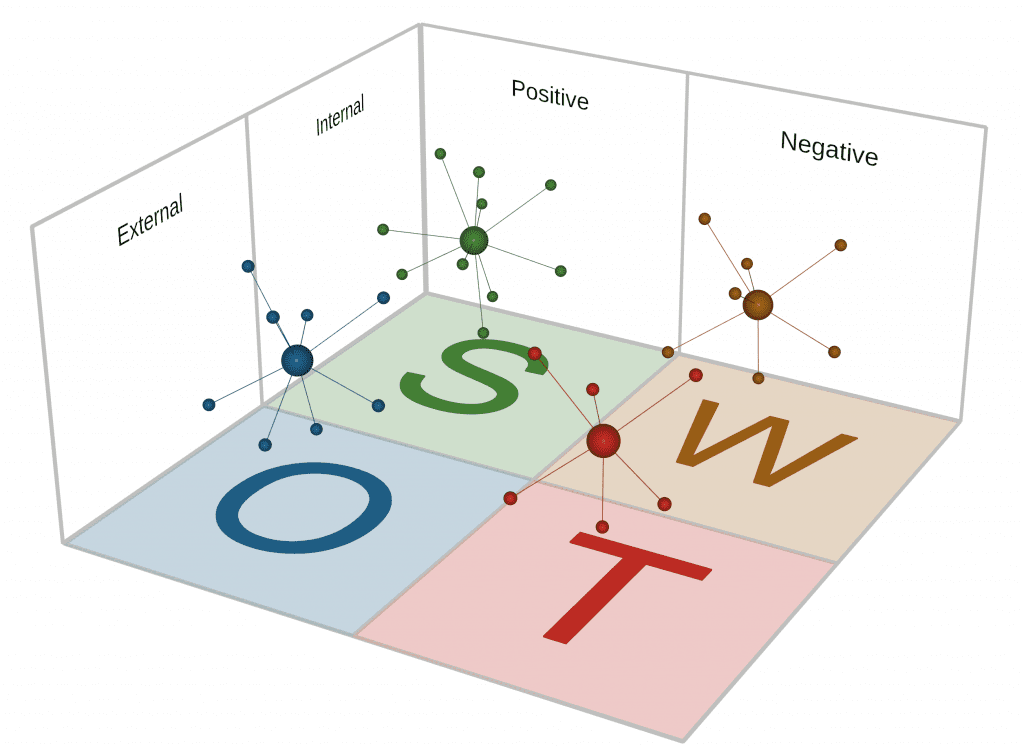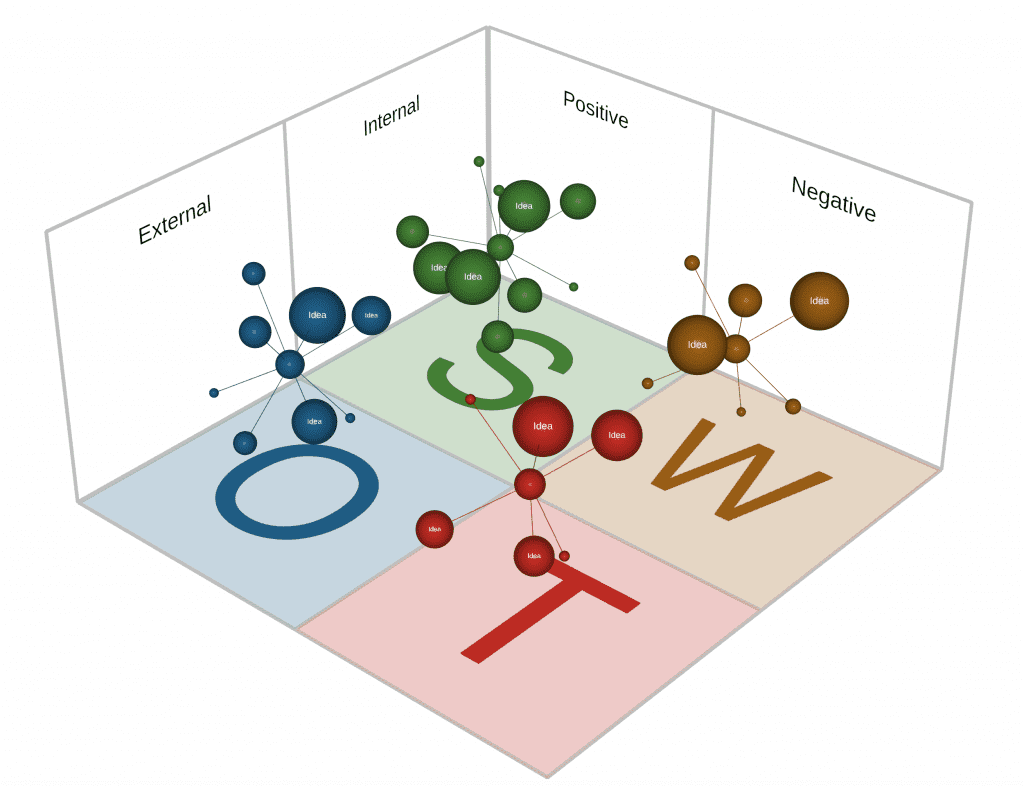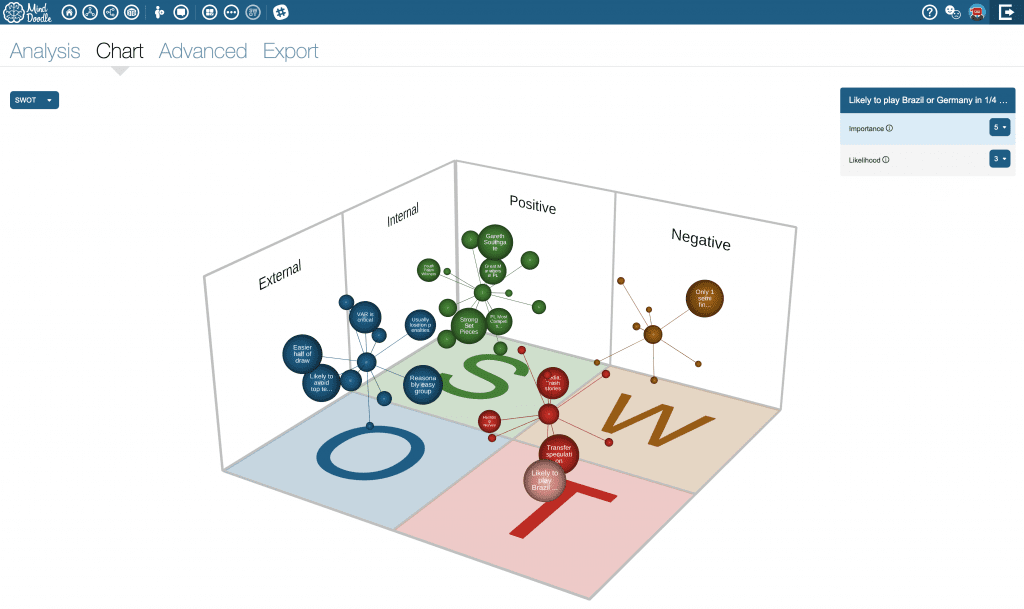Understanding Advanced SWOT Analysis
The data generated through SWOT analysis is incredibly valuable. The results can inform long-term strategic decisions, or flag up areas that require immediate action.
During SWOT analysis, a business will identify internal strengths and weaknesses, and external opportunities and threats. SWOT analysis can put a spotlight on a gap in the market, or highlight a major business risk.
However, using standard SWOT analysis techniques, some businesses can fall short. Some strengths are major, while others are minor. With standard SWOT analysis, these might appear to be equal, when in reality, they are not.
The solution is advanced SWOT analysis.
Advanced SWOT analysis provides a mechanism for assessing each factor based on its own merits. This generates a higher quality comparison and highlights the factors that you should be prioritized when setting out a plan of action.


The images above illustrate the difference between standard SWOT analysis and advanced SWOT analysis.
Each factor within the standard SWOT analysis image appears the same. In reality, it is far more complex than this, which is where the benefits of advanced SWOT analysis come into play.
During advanced SWOT analysis, complexities such as likelihood and importance are taken into account, providing a more in-depth assessment with improved accuracy.
Strengths, weaknesses, opportunities and threats
During SWOT analysis, you will assign each factor relating to a project or business into one of four categories:
- Strengths
- Weaknesses
- Opportunities
- Threats
Strengths and weaknesses work slightly differently to opportunities and threats.
Internal factors
Strengths and weaknesses are internal factors. These are things an organization or business has direct control over.
We can calculate the impact of each internal factor by assigning numerical values based on:
- Importance
- Internal rating
External factors
Conversely, opportunities and threats are external factors. These are things that may or may not happen and are outside of your control.
We can calculate the impact of each external factor by assigning numerical values based on:
- Importance
- Likelihood
Importance
During advanced SWOT analysis, you can score each factor with numeric values.
For every strength, weakness, opportunity or threat, assign a value of importance. This is a numeric value between 1 and 5.
- For very important factors, assign the highest value: 5.
- For factors that are not very important, you can assign the lowest value: 1.
Assigning a value for importance works the same for all SWOT categories, regardless of whether they are internal or external.
Internal rating
Using advanced SWOT analysis, you can look closely at each factor you have assigned. For example, you can assess each strength and decide if it a major or minor strength.
As an organization, you will have some key strengths. These are areas where you excel. You can assign these as major strengths. On the other hand, some factors are strengths but not as strong. Assign them as minor strengths.
- For major strengths, assign the highest value: 3
- For neutral strengths, assign the middle value: 2
- For minor strengths, assign the lowest value: 1
Similarly, any organization will have areas that are weaker. Some will be minor weaknesses, indicating room for improvement. Some will be major weaknesses that require immediate attention.
- For major weaknesses, assign the highest value: 3
- For neutral weaknesses, assign the middle value: 2
- For minor weaknesses, assign the lowest value: 1
Likelihood
Opportunities and threats relate to external factors. These are things an organization does not have direct control over. This can range from a competitor’s product to new legislation, such as GDPR. In extreme cases, external factors could reference constitutional changes like Brexit.
However, as these factors exist outside of an organization, it’s not possible to know if they will definitely happen (although you know that they might happen).
For opportunities and threats, assign a likelihood value based on how likely it is that the opportunity or threat will transpire.
- If it is very likely, assign the highest value: 3
- If it is neutral, assign the middle value: 2
- If it is very unlikely, assign the lowest value: 1
SWOT analysis key
Importance – How important is this in your market?
High (5) – This is vitally important.
Low (1) – This has a minimal effect.
Internal rating: Strengths – Is this a major or minor strength?
Major (3) – We excel at this, it’s our forte.
Minor (1) – We do this, but could do it a lot better.
Internal rating: Weaknesses – Is this a major or minor weakness?
Major (3) – We don’t do this at all, or we do it badly.
Minor (1) – It’s not something we focus on, but we don’t do it too badly.
Likelihood – How likely is this to happen?
High (3) – Nothing is definite in life, but this is as close as it gets.
Low (1) – Never say never, but this is probably not going to happen.
Calculating impact
To calculate the impact of strengths, weaknesses, opportunities and threats during SWOT analysis, we multiply the importance by either the internal rating or likelihood, depending on whether the factors are internal or external.
The mathematical calculations for all factors is the same, generating values between 1-15.
For example, if you score a strength (which is an internal factor) with the highest possible value for importance and internal rating, you will achieve an impact value of 15.
Importance (1-5)
Value: 5
Internal rating (1-3)
Value: 3
Impact = Importance x internal rating
Value: 15
If you score a threat (which is an external factor) with middle values for both importance and likelihood, you will achieve an impact value of 6.
Importance (1-5)
Value: 3
Likelihood (1-3)
Value: 2
Impact = Importance x likelihood
Value: 6
Tool for advanced SWOT analysis
Mind Map Pro has tools for conducting advanced SWOT analysis. Firstly, there is a visual tool for assigning factors as strengths, weaknesses, opportunities and threats, which uses a drag-and-drop technique.
Moving to advanced SWOT analysis, there is a table for scoring the SWOT factors. All SWOT factors have an importance value. Internal factors have an internal rating, whereas external factors have a likelihood value. These are calculated to create the impact values.

Mind Map Pro also generates interactive 3D chart that shows the results of SWOT analysis visually.
Each strength, weakness, opportunity and threat is represented as a sphere. The size of the sphere demonstrates the impact value, with a larger size correlating with a higher impact value.
This provides immediate visual feedback, which is much easier to understand than a traditional table.

To create a plan of action, you can assign tasks to each factor in order to strengthen weaknesses, capitalise on opportunities and mitigate against risks.
Advanced SWOT analysis example
We’ve created some short video examples that take you through SWOT analysis using Mind Map Pro.
If you saw Greenpeace’s Rang-tan animation, watch our basic SWOT analysis and advanced analysis of its use in the Iceland Christmas advert.
Football fans can enjoy our SWOT analysis series analysing England’s chances in the 2018 FIFA World Cup.
To learn more about using Mind Map Pro for SWOT analysis, here are some helpful guides:
- Get started by following our guide on SWOT analysis
- Level up with our guide on advanced SWOT analysis
- Discover how to generate 3D SWOT charts
- Finally, learn how to add tasks during SWOT



